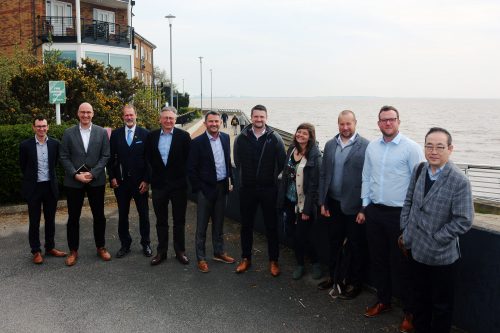Energy Transition: Powering a new direction for the Humber

Last October, the Humber Energy Board released Humber Vision 2030 – a plan by which the ‘Energy Estuary’ could cut carbon emissions by 80% with £15bn investment.
The document brought together a number of ongoing strands in the area’s pursuit of renewable energy, decarbonisation and carbon capture.
TheBusinessDesk,com, in association with Deloitte, brought a team of business and academic experts together at The Deep Business Centre in Hull to look at the estuary’s ambitions and the challenges they face in pursuit of clean energy.
Dr Agota Mockute, of the University of Hull, summed up the potential: “The thing that excites me
Glenn Jensen, senior assistant principal for employer engagement at Hull’s Ron Dearing University Technical College, agreed. “We are now at the beginning of an energy transition. And we are a perfectly placed to lead, not just nationally but globally.”
Much of the attention is on major projects such as offshore wind farms – Hornsea 2, off the East Rising coast, overtook Hornsea 1 as the world’s largest wind farm last year. Dogger will be bigger yet, we also wanted to explore what smaller firms can do – after all, SMEs consume 55% of UK business energy.
Rob Burgin is managing director of CorrBoard, a Scunthorpe packaging firm which now generates its own electricity from an on-site waste food plant and is now exploring ways to capture biogas produced in cardboard manufacturing and become carbon neutral.
“If a small, independent business like ourselves can have such an extensive investment, it demonstrates the art of the possible if you really want to push forward.”
On the larger scale, the Humber is hosts several multinational oil firms, all exploring alternative energy sources as part of the transition.
Chris Gilbert is manager of Humber decarbonization projects at US-based Phillips 66, which runs a used cooking oil refinery producing sustainable aviation fuel. “We’re looking at all aspects of how to decarbonise our operations and our products. We started several years ago.”
The Humber’s development of carbon capture and hydrogen energy, he said, would attract outside investment. “We want to see this low carbon ecosystem and infrastructure happen as we see it as a base for further opportunities.”
Professor Xudong Zhao is director of the University of Hull’s Centre for Sustainable Energy Technologies, where he and his team develop cutting edge technology and processes, including solar and geothermal energy. One of their ongoing projects is developing multiple-source heat pumps. “We successfully developed a two-source heat pump, then we move to three-source, four-source. We’ll make a small-scale prototype, which costs much less, but we’re more than happy to explore this initiative.”
Legislation
Several experts felt the carrot and stick of legislation and incentives could help push companies further into energy transition.
Jensen, of Ron Dearing University Technical College, felt better regulations around energy consumption in new buildings could drive significant progress. “Unless we start looking at legislation and pushing forward, companies are always looking at profit before they look at the carbonisation,: he said. “And I think that is one of the biggest areas that we need to look at.”
Chris Coath, director of energy and asset management at engineering and construction firm NG Bailey, agreed. “That’s the greatest challenge faced on the demand side by our customers. There’s no real future set out by the government. They don’t plan.
“We’ve got all the technology, all the innovation, all the right people in the UK to build to the required standard to hit net zero by 2050. We’re just not doing enough of it, and people are still making poor decisions because there’s no certainty.”
Ian Livingston, project manager for low carbon activities at refiners Equinor, said better planned funding would help to spread risk.
“The risk, particularly in hydrogen and carbon capture and storage, are so large and so varied that its difficult for any one company to go in and make their own investment.”
At the moment, he said, subsidies often restricted activities. “You’re beholden to government. We could choose to take our CO2 to Norway, but we’re not allowed. If we do that we don’t get access to the subsidy funding that help customers buy hydrogen from us at the same price as natural gas.”
Arran Taylor, lead partner for energy transition at Deloitte, said business could take the lead rather than wait for covic bodies to be the convenor. “I’ve seen that not just in the UK bot around the world, where businesses have said, right, we’re going to stick our necks out.
“We see commercial opportunity in this over a long-term horizon. We’re looking to make those transformational investments that strength of bringing several business together.
“And quite often when those conditions are allowed to flourish, it’s easier for government to come in and sprinkle a little bit of extra that becomes and accelerator and a catalyst.”
Collaboration
One of the notable factors of the Humber area is how much companies are working together.
Gilbert, of Phillips 66, said, “The region has moved a lot over the past three to four years in terms of collaboration, working together. As a company, that’s a change in mindset because a lot of the companies are our competitors, but we’re working together in the decarbonisation space.”
Phil Glover, net zero hub project lead at Hull and Easy Yorkshire LEP, spoke in favour of industrial symbiosis. “It basically means looking at someone whose waste stream is someone else’s feedstock,” he said.
“It brings parties together in sectors that may not talk to each other, which for me is where the magic is. Everybody knows what the competitors are in their sector. But when you look at cross-sector, say construction and agriculture, growing the produce that actually goes into contraction blocks. Wastewater is a good one, district heating, particularly if we’re wasting that heat.
“Think about productivity and efficiencies. All business do that in their own right, but when you start to think between business, that’s the game changer.”
Burgin, of CorrBoard, agreed. He was working the Lincolnshire LEP, he said, to take some of the county’s grass trimmings as a biomass fuel. “Lincolnshire’s got 12,000 miles of hedges that need trimming every year. Can we take someone else’s waste? Let’s stop calling it waste and start calling it a resource. That’s the discussion that need to be understood.”
David Kennedy, managing director of Pure Renewables, added, “For me, it’s quite simple. We need to start delivering, we’re doing an awful lot of talking ands we need to crack on, quite frankly.
“It’s a massive elephant and we need to eat it, but let’s eat is one bite at a time. It’s really quite simple, and it doesn’t need to be scary. And we’re all here to help each other really. That’s my view.”








